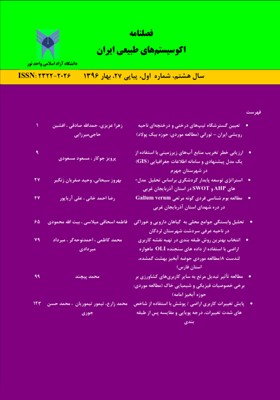مطالعه تأثیر تبدیل مرتع به سایر کاربریهای کشاورزی بر برخی خصوصیات فیزیکی و شیمیایی خاک (مطالعه موردی: حوزه آبخیز امامه)
محورهای موضوعی : جنگلداری
1 - کارشناس ارشد مرتعداری اداره کل منابع طبیعی و آبخیزداری استان هرمزگان
کلید واژه: تغییر کاربری اراضی, خصوصیات فیزیکی و شیمیایی خاک, امامه,
چکیده مقاله :
تبدیل مرتع به اراضی کشاورزی، عموماٌ تأثیر جدی بر میزان ماده آلی و دیگر ویژگیهای فیزیکی و شیمیایی خاک میگذارد. این پژوهش با هدف بررسی اثرات تغییر کاربری اراضی مرتعی بر خصوصیات خاک در حوزه آبخیز امامه انجام شد. چهار کاربری شامل مرتع، باغ، آیش و کشاورزی انتخاب گردید. نمونهبرداری از خاک به صورت تصادفی (5 تکرار در هر کاربری) از عمق 30-0 سانتیمتری صورت پذیرفت. برخی مشخصههای خاک شامل هدایت الکتریکی، گراول (شاخص فرسایشپذیری خاک)، آهک کل، درصد رطوبت اشباع خاک، pH، منیزیم، سدیم، کربن، پتاسیم و فسفر اندازهگیری شد. نتایج حاصل از تجزیه و تحلیل آماری نشان داد که تغییر کاربری اراضی مرتعی به کشاورزی، آیش و باغ تغییرات معنیداری را در مقادیر اسیدیته، منیزیم و سدیم ایجاد نکرده است. در حالیکه هدایت الکتریکی، گراول، آهک کل، درصد رطوبت اشباع خاک، کربن آلی، پتاسیم و فسفر در اثر تغییر کاربری اراضی، بهصورت معنیداری تغییر کردند. نتایج نشان داد که با تبدیل کاربری مرتع به سایر کاربریها، میزان درصد آهک، پتاسیم، فسفر و گراول کاهش یافته و این کاهش در کاربری آیش و کشاورزی نسبت به سایر کاربریها بیشتر است. مقدار کربن خاکهای مرتعی نیز در اثر تغییر کاربری به باغ و کشاورزی، به طور معنیداری افزایش یافت. همچنین هدایت الکتریکی، رطوبت اشباع خاک، پتاسیم، فسفر و کربن در کاربری باغ به طور معنیداری بیشتر از بقیه کاربریها بود. به طور کلی نتایج این تحقیق نشان داد که تغییر کاربری اراضی تأثیر معنیداری بر خصوصیات خاک دارد.
The change of rangeland to agricultural lands has serious effects on the amount of soil organic matter and physico- chemical characteristics. This study was conducted to investigating the effects of rangeland conversion into agricultural land use on soil properties in Amameh watershed (Tehran province). Four land use types were selected including rangeland, fallow, orchard and agricultural lands. Soil sampling was carried out as random systematic method (three repeat for each land use) from 0-30 cm depths. Some soil properties such as pH, electrical conductivity, calcium carbonate, sodium, Saturation, magnesium, phosphorus, potassium, carbon and gravel were measured. Statistical analysis were also performed on the data and the results showed that changing land use from rangeland to agricultural lands, fallow and orchard did not show any significant changes on pH, Mg and Na; whereas electrical conductivity, gravel, calcium carbonate, Saturation, carbon, potassium and phosphorus showed significant changes due to the land use change. The results revealed that by changing land use from rangeland to other use types the amounts of calcium carbonate, phosphorous, potassium and gravel have decreased, more obviously in fallow and agricultural lands. In addition, soil carbon increased, this was due to land-use conversion from rangeland to orchard and agriculture. Moreover, electrical conductivity, Saturation, potassium, phosphorus and carbon in the orchard were significantly higher than the other land uses. Generally, results of this study showed that changing land use had significant effect on the soil properties.
1. Abbasi, M. Najafinejad, A. Sheikh, V.B. and Azim Mohseni, M. (2016). Changes in runoff, Soil and nutrient loss in different vegetation cover type in Loess lands (Case study: Kechik watershed, Golestan province). Journal of Water and Soil Conservation, 23 (3): 91-109. (in Persian).
_||_

